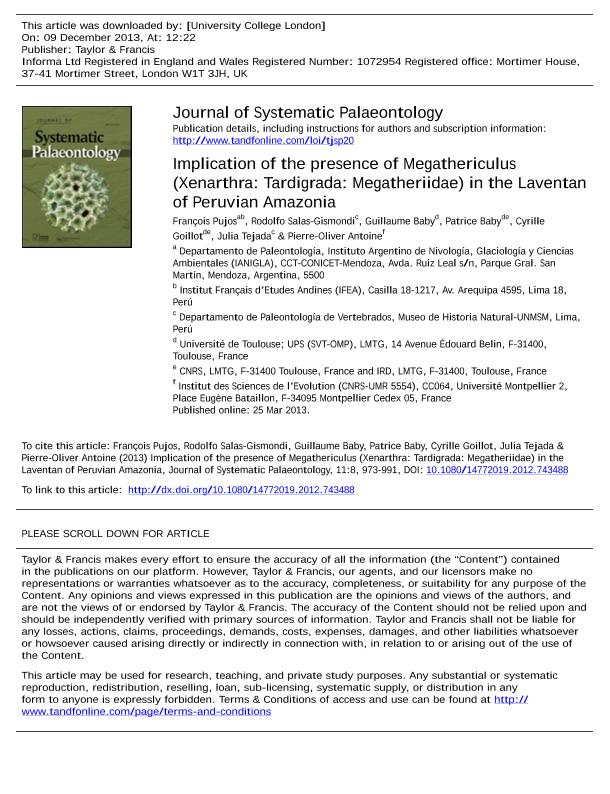Artículo
Implication of the presence of Megathericulus (Xenarthra: Tardigrada: Megatheriidae) in the Laventan of Peruvian Amazonia
Pujos, François Roger Francis ; Salas Gismondi, Rodolfo; Baby, Guillaume; Baby, Patrice; Goillot, Cyrille; Tejada, Julia; Antoine, Pierre Olivier
; Salas Gismondi, Rodolfo; Baby, Guillaume; Baby, Patrice; Goillot, Cyrille; Tejada, Julia; Antoine, Pierre Olivier
 ; Salas Gismondi, Rodolfo; Baby, Guillaume; Baby, Patrice; Goillot, Cyrille; Tejada, Julia; Antoine, Pierre Olivier
; Salas Gismondi, Rodolfo; Baby, Guillaume; Baby, Patrice; Goillot, Cyrille; Tejada, Julia; Antoine, Pierre Olivier
Fecha de publicación:
25/03/2013
Editorial:
Taylor & Francis
Revista:
Journal of Systematic Palaeontology
ISSN:
1477-2019
Idioma:
Inglés
Tipo de recurso:
Artículo publicado
Clasificación temática:
Resumen
Middle Miocene remains of giant megatheriine ground sloths (Tardigrada: Megatherioidea) are scarce and generally located in southern South America. The discovery of a well-preserved edentulous dentary of Megathericulus sp. from the Middle Miocene (Laventan South American Land Mammal Age - SALMA; 13.5-11.8 Ma) of the Amazonian Peru increases our knowledge of this genus, which had previously been recognized in Argentina. A preliminary revision of the earliest Megatheriinae allowed clustering the four middle Miocene species within the genus Megathericulus Ameghino: M. patagonicus Ameghino, M. primaevus Cabrera, M. andinum (Kraglievich), and M. cabrerai (Kraglievich). This small-sized genus is mainly characterized by a lateral depression that borders m1, a posterior external opening of the mandibular canal anterior to the base of the ascending ramus that opens anteriorly or anterodorsally, the base of the symphysis located anteriorly to the m1, important anteroposterior compression of the teeth, elongation of the region of the maxilla anterior to the M1, humerus elongated and gracile, patellar trochlea of femur contiguous with medial and lateral articular facets for tibia, strongly developed odontoid tuberosity, and astragalus with prominent odontoid process. The genus Eomegatherium Kraglievich is therefore restricted to the Huayquerian SALMA of Argentina and represented by a single species, E. nanum Burmeister. Megatheriinae constitute the first clade of Tardigrada in which the caniniform tooth has been secondarily modified into a molariform tooth. Three molariform patterns can be observed during megatheriine evolution in relation to tooth compression and loph or lophid orientation. Middle Miocene Megatheriinae occur only in the westernmost part of South America. These giant ground sloths might have dispersed latitudinally from Colombia/Patagonian Argentina before colonizing eastern areas of Andean South America (Bolivia, Venezuela, north, and east of Argentina) during the late Miocene and early Pliocene.
Archivos asociados
Licencia
Identificadores
Colecciones
Articulos(IANIGLA)
Articulos de INST. ARG. DE NIVOLOGIA, GLACIOLOGIA Y CS. AMBIENT
Articulos de INST. ARG. DE NIVOLOGIA, GLACIOLOGIA Y CS. AMBIENT
Citación
Pujos, François Roger Francis; Salas Gismondi, Rodolfo; Baby, Guillaume; Baby, Patrice; Goillot, Cyrille; et al.; Implication of the presence of Megathericulus (Xenarthra: Tardigrada: Megatheriidae) in the Laventan of Peruvian Amazonia; Taylor & Francis; Journal of Systematic Palaeontology; 11; 8; 25-3-2013; 973-991
Compartir
Altmétricas



